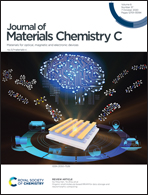Non-halogenated solvent-processed highly efficient green Ir(iii) complexes with an external quantum efficiency exceeding 23% for phosphorescent organic light-emitting diodes†
Abstract
In the present study, three new highly efficient green emitting heteroleptic Ir(III) complexes based on 5H-benzo[c][1,5]naphthyridin-6-one derivatives were designed and synthesized for solution-processed PHOLEDs. The Ir(III) complex Ir1 consists of multifunctional 4-(2-ethoxyethoxy)picolinate as an ancillary ligand, whereas the Ir(III) complexes Ir2 and Ir3 contain conventional ancillary ligands, such as picolinate. Their corresponding photophysical, thermal and electrochemical properties were fully investigated. All three Ir(III) complexes exhibited intense green emission in solution at room temperature with high photoluminescence quantum yields (PLQYs). The optimized solution-processed green PHOLEDs exhibited a maximum external quantum efficiency (EQEmax) of 24.56% with the maximum current efficiency (CEmax) of 87.96 cd A−1 for Ir1 using a halogenated solvent, such as chlorobenzene for device fabrication. Additionally, we achieved a high EQEmax of 23.60% with CEmax of 85.22 cd A−1 for Ir1 using non-halogenated solvent, such as cyclohexanone for PHOLED fabrication. The Ir(III) complex, Ir1 showed a high electroluminescence brightness of 36 762 cd m−2 compared to Ir2 and Ir3. To the best of our knowledge, the maximum EQE and CE of Ir1 is ranked the highest value among the Ir(III) complexes using a non-halogenated solvent for the fabrication of PHOLEDs to date.



 Please wait while we load your content...
Please wait while we load your content...